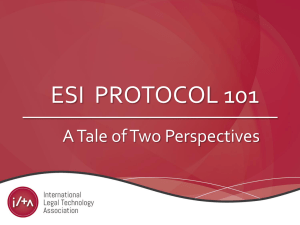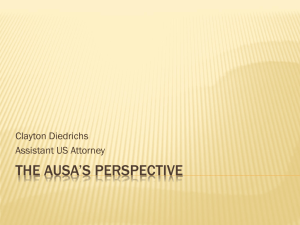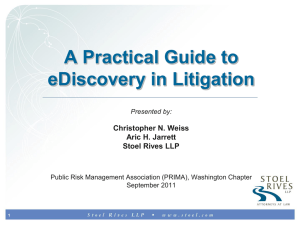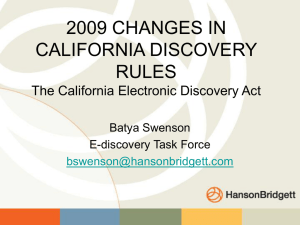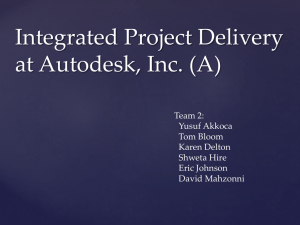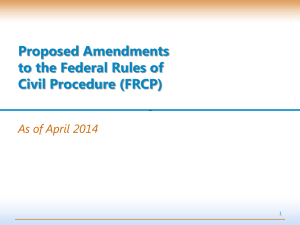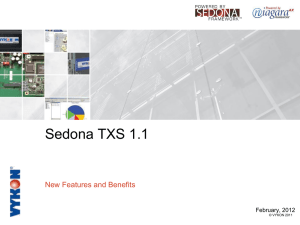Presentation - Perkins Coie
advertisement
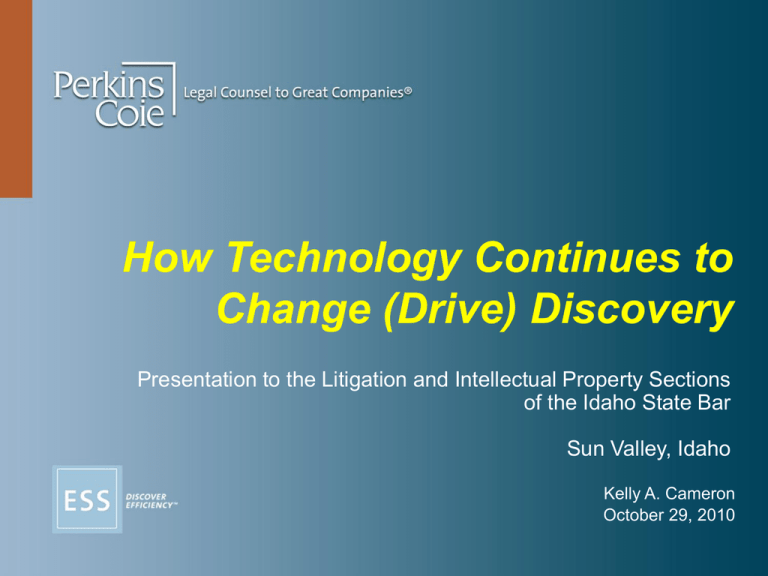
How Technology Continues to Change (Drive) Discovery Presentation to the Litigation and Intellectual Property Sections of the Idaho State Bar Sun Valley, Idaho Kelly A. Cameron October 29, 2010 "There's nothing out there?" 2 The Rules – Federal and State Federal Rules of Civil Procedure 26(f)(3)(C) – Discovery Plan/ESI 34(a)(1)(A) – Generally 34(b)(1)(C) – Request/Form 34(b)(2)(D) & (E) – Response/Form Idaho Rules of Civil Procedure 34(a) – ESI = "Document" but 34(b) – "specifically request" 3 Survey of 5,000 Lawyers finds: 98% report that 'digital evidence' had been "vital to the success of legal matters" with past 24 months 60% "struggled" with volume of data 51% admit to "problems identifying and recovering" ESI 29% complain of lacking time to "conduct thorough investigations" 24% admit lacking "sufficiently sophisticated e-discovery technology to fulfill requests effectively" Source: Secure Business Intelligence Magazine, "Difficulties Producing 'Digital Evidence' Cause Lawyers to Lose Cases" (9/7/10) http://www.scmagazineuk.com/difficulties-producing-digital-evidence-cause-lawyers-to-lose-cases/article/178333/ 4 The Big Picture: Five Considerations for Today 5 (1) Identification Know Your Custodians and Sources of ESI Identify Document Custodians Review Complaint, demand letters, etc. Talk to key stakeholders Review organizational charts Schedule Interviews of Document Custodians In-person is always best (if possible) Don't forget to interview IT department Common Sources of Documents and ESI: Corporate and personal email systems Desktop or laptop computers External or networked ("shared") drives Instant Messaging Systems (including text messaging) Internet and Social Networking sites Cloud Computing sites Backup Systems, media, and applications Traditional hard copy/paper files 6 (2) Preservation Send Hold Notices and Track Compliance Issue Written Document Hold Notices Describe litigation and claims Make clear relevant documents and ESI must be retained Ask custodians to acknowledge receipt, understanding, and commitment to full compliance Custodians to notify HR or legal if they are departing the company, transferring, or changing jobs Consider Suspending Routine Data Management Policies and Processes Automatic email deletion Backup recycling procedures – this may be the sole source of relevant information from key players whose data not otherwise readily accessible Document retention policies and archiving Manage Document Hold Notices Send periodic reminders Actively monitor compliance Coordinate with HR regarding departures, transfers, or job changes Consider engaging third party/e-Discovery vendors, tools, and/or software 7 (3) Collection Collect ESI Promptly and Correctly Once Relevant Custodians are Identified, Noticed & Interviewed . . . Collect documents and ESI quickly Usually includes personal interviews with custodians Involve yourself in the process – treat this as a non-delegable duty Document and monitor all preservation efforts, decisions, chain of custody, etc. Collection Options Guided Collection Active Data Collection Forensic Collection An aside re: "End User-Based eDiscovery" – Avoid it if you can Be Wary of Metadata "Data about Data" Includes everything from header information in email to revision history for documents Collection method can alter certain metadata (e.g., last opened date or last modified date) Encourage use of third party for collection (ultimately cost-effective and safer) 8 (4) Processing and Review Early Case Assessment is Key Processing Considerations What file types will be excluded? What search terms will be used? Cooperative, iterative, discovering party, or responding party? Be careful. Expert (subject matter or technical) help required? What other exclusions will apply (ACP, date, and custodian restrictions, etc.)? Vertical or horizontal de-duplication, or both? Highlighting for substance, privilege, work product, privacy, "Hot Docs," etc. Exception reports (corrupted, password protected, encrypted, foreign language, etc.) – automated or manual? Review Considerations Linear Review Platforms (Concordance/FYI) Strategic Review Platforms (Attenex, Clearwell, Relativity) Large Firms with "Review Centers" (80 plus attorneys, "firm within the firm") 9 (5) Production Seek Agreement When Possible Rule 26(f) requires parties to discuss (among other things) the "disclosure or discovery of [ESI], including the form or forms in which it should be produced." Volumes of data are so large, and the cost of review and production are so great, that parties must discuss production issues in advance. Common Topics for Rule 26(f) Conference Identity of custodians Privilege issues (including Clawback Agreements) Potential and anticipated volume of data Search strategies to reduce data for review (agreement on search terms, etc.) Realistic timeline for production Production format Native Static TIFF or PDF Images Combination thereof for different types of documents Common "Reasonably Usable" Production Format Static TIFF or PDF Images Load File containing negotiated metadata in agreed-to format/software Extracted or OCR text (for keyword searching capability) 10 Single most informative (authoritative?) resource for ESI issues, best practices, overviews, and current state-of-the art and law Developed "Working Group Series" ("WGS ") in 2002 SM Transitory and focused think-tanks to develop principles, guidelines & best practices in targeted areas "ripe" for development Regular Season Conferences serve to both launch Working Groups and comment on output WG1 – Electronic Document Retention & Production Organized in mid-2002 Goal is to advance the reasoned and just development of the law Built on breadth and depth of experience of invitees (participants) & observers Designed around the dialogue model of achieving consensus Evolving, not static; address "tipping points" Life span based on need, goals & objectives as determined by the Working Group 11 Glossary 55 pages Updated September 2010 www.thesedonaconference.org 12 Principles of Cooperation [A] national drive to promote open and forthright information sharing, dialogue (internal and external), training and the development of practical tools to facilitate cooperative, collaborative, transparent discovery. This Proclamation challenges the bar to achieve one's goals and refocus litigation toward the substantive resolution of legal disputes. The Sedona Conference Cooperation Proclamation at 1 (2008). www.thesedonaconference.org 13 Principles of Cooperation – cont'd Cooperation vs. Zealous Advocacy – a False Choice Over-contentious discovery is a cost that has outstripped any advantage in the face of ESI and the data deluge. It is not in anyone's interest to waste resources on unnecessary disputes, and the legal system is strained by 'gamesmanship' or 'hiding the ball,' to no practical effect. The Sedona Conference Cooperation Proclamation at 1 (2008). www.thesedonaconference.org 14 Principles of Proportionality 1. The burdens and costs of preservation of potentially relevant information should be weighed against the potential value and uniqueness of the information when determining the appropriate scope of preservation. The Sedona Conference WG1, Commentary on Proportionality in Electronic Discovery, 11 The Sedona Conference J. 289, 291 (Fall 2010). www.thesedonaconference.org 15 Principles of Proportionality – cont'd 2. Discovery should generally be obtained from the most convenient, least burdensome, and least expensive sources. The Sedona Conference WG1, Commentary on Proportionality in Electronic Discovery, 11 The Sedona Conference J. 289, 291 (Fall 2010). www.thesedonaconference.org 16 Principles of Proportionality – cont'd 3. Undue burden, expense, or delay resulting from a party's action or inaction should be weighed against that party. The Sedona Conference WG1, Commentary on Proportionality in Electronic Discovery, 11 The Sedona Conference J. 289, 291 (Fall 2010). www.thesedonaconference.org 17 Principles of Proportionality – cont'd 4. Extrinsic information and sampling may assist in the analysis of whether requested discovery is sufficiently important to warrant the potential burden or expense of its production. The Sedona Conference WG1, Commentary on Proportionality in Electronic Discovery, 11 The Sedona Conference J. 289, 291 (Fall 2010). www.thesedonaconference.org 18 Principles of Proportionality – cont'd 5. Nonmonetary factors should be considered when evaluating the burdens and benefits of discovery. The Sedona Conference WG1, Commentary on Proportionality in Electronic Discovery, 11 The Sedona Conference J. 289, 291 (Fall 2010). www.thesedonaconference.org 19 Principles of Proportionality – cont'd 6. Technologies to reduce cost and burden should be considered in the proportionality analysis. The Sedona Conference WG1, Commentary on Proportionality in Electronic Discovery, 11 The Sedona Conference J. 289, 291 (Fall 2010). www.thesedonaconference.org 20 Legal Hold Commentary and Guidelines Guideline 1 A reasonable anticipation of litigation arises when an organization is on notice of a credible probability that it will become involved in litigation, seriously contemplates initiating litigation, or when it takes specific actions to commence litigation. The Sedona Conference WG1, Commentary on Legal Holds: The Trigger & The Process, 11 The Sedona Conference J. 265, 2269 (Fall 2010). www.thesedonaconference.org 21 Legal Hold Commentary and Guidelines – cont'd Guideline 5 Evaluating an organization's preservation decisions should be based on the good faith and reasonableness of the decisions undertaken (including whether a legal hold is necessary and how it should be executed) at the time they were made. The Sedona Conference WG1, Commentary on Legal Holds: The Trigger & The Process, 11 The Sedona Conference J. 265, 2269 (Fall 2010). www.thesedonaconference.org 22 Legal Hold Commentary and Guidelines – cont'd Guideline 6 The duty to preserve involves reasonable and good faith efforts, taken as soon as is practicable and applied proportionately, to identify and, as necessary, notify persons likely to have relevant information to preserve the information. The Sedona Conference WG1, Commentary on Legal Holds: The Trigger & The Process, 11 The Sedona Conference J. 265, 2269 (Fall 2010). www.thesedonaconference.org 23 Legal Issues in Recent Federal Case Law Privilege and Inadvertent Disclosure Legal Holds Failure to Implement and/or Monitor Spoliation Data Destruction Culpability – Negligent, Gross Negligent 24 Privilege and Clawback 25 Privilege and Inadvertent Disclosure Mt. Hawley Ins. Co. v. Felman Production, Inc., 2010 WL 1990555 (S.D. W. Va. May 18, 2010) Facts: You are in Federal Court and have produced over 1 million pages of data. 377 privileged emails slipped through and were produced to the opposing party. Fortunately, you have a clawback agreement. You used keywords to find responsive documents, tested the search terms (for spelling variants) but you did not sample for relevancy, or over- or under-inclusiveness and did not have "eyes on" responsive non-privileged documents. Holding: Privilege waived. 26 Inadvertent Disclosure – Federal Rule of Evidence 502(b) Disclosure is not a waiver if: (1) disclosure is inadvertent; (2) the holder of the privilege took reasonable steps to prevent disclosure; and (3) the holder promptly took reasonable steps to rectify the error, including (if applicable) following Fed. R. Civ. P. 26(b)(5)(B). 27 Inadvertent Disclosure: What are reasonable steps to prevent disclosure? Fed. R. Evid. 502(b)(2) Sampling to test the reliability of keyword searches of documents determined NOT to contain privileged information. "Eyes-on" review of potentially privileged documents. Consistency between privilege log and production. When on notice that some privileged documents were produced, establish QC protocol to find others. What appears to have bothered the Court the most in Mt. Hawley was the document/data "dump" without review or sampling resulting in an overproduction of more than 30% and fact that counsel was well aware of rules, factors, and consequences. 28 Inadvertent Disclosure under Idaho Rule of Civil Procedure 26(b)(5)(B) No intent to waive Notification of inadvertent disclosure with a "reasonable time" Prepare or add it to the Privilege Log required under Rule 26(b)(5)(a) Recipient must promptly "return, sequester, or destroy" the specified information and any copies Producing party must preserve pending ruling by the court 29 Legal Holds and Spoliation "Spoliation is 'the destruction or significant alteration of evidence, or the failure to preserve property for another's use as evidence in pending or reasonably foreseeable litigation.'" Zubulake v. UBS Warburg ("Zubulake IV") 220 F.R.D. 212, 216 (S.D.N.Y. 2003) 30 First Step . . . Initiate Hold Notices Remember Sedona Guideline 1: Reasonable anticipation of litigation arises when an organization is on notice of a credible threat it will become involved in litigation or anticipates taking action to initiate litigation. 31 Initiating Hold Notices (cont'd) Reasonably anticipated, threatened or pending litigation or investigation Applies to the initiator and target of litigation Arises from: Common law duty to avoid spoliation evidence Inherent power of the courts Rules governing sanctions (e.g., Rule 37) Necessary to avoid "collateral litigation" Duty may be ambiguous but can count on it being second-guessed/scrutinized Based on good faith and reasonable evaluation of facts as known at time 32 Pension Committee (Zubulake Revisited): Highlights Pension Committee of Univ. of Montreal Pension Plan v. Banc of America Securities, Inc., 2010 WL 184312 (S.D.N.Y. Jan. 15, 2010) Analytical framework for determining whether sanctions for spoliation are warranted: Level of culpability – negligent, grossly negligent or willful; Interplay between the duty to preserve and spoliation; Burden of proof – who has the burden of proving that evidence has been lost or destroyed and the consequences resulting from that loss; and Appropriate remedy for the harm caused by the spoliation. 33 Pension Committee: Missteps that Led to Opinion Some of the plaintiffs anticipated filing suit in 2003; hold notices not issued, nor ESI collected, until 2007 Before 2007, total reliance on plaintiffs' employees to select responsive records, without oversight by counsel (beware of "End-User Based e-Discovery") Initial declarations served by plaintiffs explaining conduct were materially incorrect – having to serve amended declarations didn't help their case – credibility key? 34 Lessons from Pension Committee "Courts cannot …expect that any party can meet the standard of perfection." But… "A failure to preserve evidence resulting in the loss or destruction of relevant information is surely negligent and …may be grossly negligent or willful." So remember… What is negligent or worse will be considered in hindsight with your opponent complaining that we can never know for sure which critical documents and evidence were lost. 35 Specific Guidance re: Culpability from Pension Committee Negligence: Failure to execute a comprehensive search for documents or to monitor document collection (at least negligent); Failure to assess accuracy and validity of search terms; Failure to obtain records from all employees, including those tangentially related (likely negligent). Gross Negligence (when duty to preserve attaches): Failure to issue a written legal hold (legal hold triggers); Failure to identify key players and ensure that their electronic and paper records are preserved; Failure to cease the deletion of email; Failure to preserve records of former employees in a party's possession, custody or control; Failure to preserve backup tapes when they are the sole source of relevant information or when they relate to key players, if the relevant information maintained by those players is not obtainable from readily accessible sources. 36 Pension Committee: Sanctions Available Further discovery Cost shifting Adverse inference instructions Preclusion of issues/evidence Terminating Sanctions (e.g, default or dismissal) Note: The appropriate sanction is inherently subjective and discretionary. 37 Pension Committee: Practice Tips Preserve data by issuing written hold notices Interview document custodians Consider suspending data management Collect ESI promptly and correctly Know the Rules of the Road and seek expert guidance 38 ALAS Newsletter on Pension Committee Strongly recommends that ALAS firms confirm in writing their communications with clients regarding the responsibilities that client and counsel have agreed to undertake. Pension Committee suggests that counsel may have to involve themselves in the client's internal preservation efforts or risk being held responsible for conduct over which they had no control. 39 ALAS Newsletter (cont'd) Litigators should reach a clear understanding with the client about who will be responsible for the following steps: Prompt issuance of a written litigation hold notice once litigation is "reasonably anticipated;" Review of complaint or anticipated claims to identify potentially relevant subjects and key personnel with possible knowledge of documents and sources; Discussion with key employees and others to identify possible sources and locations of relevant records, and to emphasize the employees' duty to comply with any litigation hold; Discussion with client's IT personnel to confirm possible sources of relevant ESI; and Monitoring compliance with document preservation instructions and issuing periodic litigation hold reminders. 40 Victor Stanley II Victor Stanley, Inc. v. Creative Pipe, Inc., 2010 WL 3703696 (D. Md. Sep. 9, 2010) (Grimm, Mag.) 41 Victor Stanley II: Bad Facts Defendants deleted or instructed others to delete thousands of files. Defendants failed to implement a legal hold. Defendants knowingly "wiped" and overwrote hard drives and other files during the discovery period and in violation of specific court orders. Judge Grimm: Collectively Defendants' conduct constitutes the single most egregious example of spoliation that he has encountered in 14 years on the bench and in all of the spoliation cases he reviewed. Don’t Miss: Judge Grimm's table of decisions. 42 Victor Stanley II: Sanctions Defendant "consented" to default judgment on the main claim of copyright infringement. Defendant must pay all of Plaintiff's attorneys' fees incurred relating to all of the discovery abuses. Court ordered that individual Defendant's conduct be treated as contempt of the court "and that as a sanction, he be imprisoned for a period not to exceed two years, unless and until he pays to Plaintiff the attorneys' fees and costs awarded" after the itemized accounting. Epilogue: Fees submitted are over $1 million – 66% of total fees incurred by Plaintiff in the litigation. 43 Victor Stanley II: Lessons Learned Legal hold, Legal hold, Legal hold. Monitor and be knowledgeable about what your client is doing. Hire qualified and competent forensic consultants. Do not let discovery issues fester and grow. 44 Conclusions Cooperation may be your best, most costeffective discovery tool and tactic. Prophylactic and proactive management by counsel of the entire e-discovery process is paramount to avoid "discovery about discovery" and possible sanctions. The first (and perhaps most important) tool – the Litigation Hold Notice. 45 Final Advice If your case involves (or may involve) ESI, become familiar with The Sedona Conference commentaries and the leading cases (Zubulake cases, Pension Committee, Rimkus, Victor Stanley decisions, etc.) and buckle up. 46 Questions and Discussion 47

